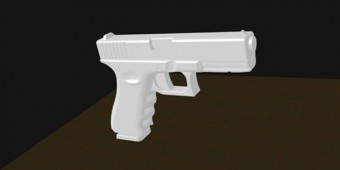
Behold the rise of the printed 3-D gun
Jeff Knox
Jeff and Chris Knox explore latest firearms technology sparking hysteria

For more than a century, every advance in firearms technology has brought with it some measure of hysteria.
In the 1860s, the threat of repeating arms falling into the hands of plains Indians caused writers of the day to spill gallons of worried ink. In the 1930s, it was fear of gangsters with machine guns which led to the National Firearms Act of 1934. There was even an attempt to restrict a “freakishly powerful” handgun that made its debut in those days – the now-common .357 Magnum. In the 1980s, the hysteria roiled over a new “plastic gun” from an Austrian designer named Glock. Of course, it turned out that the Glock had over a pound of steel in it, and it is now one of the most popular handguns in the world, used by more U.S. police departments than any other pistol.
Today, we are on the verge of seeing a “printed” gun, one that can be produced on a 3-D printer. In 3-D printing, material – usually plastic, but others are coming – is liquefied and sprayed like ink from an ink jet printer. The material builds up layer by layer to produce a three-dimensional part. A popular demonstration print is an adjustable wrench which comes out of the printer fully functional, including the free-moving jaws and threaded adjuster. Of course, anything printed on these printers is not going to be as strong or durable as it would be if it was machined or forged out of steel, and current 3-D printing materials won’t stand the heat and pressure generated inside a gun, but those issues are with current materials and printers. The technology is still in its infancy.
A group called Defense Distributed is raising funds to “crowdsource” and produce the world’s first fully printable gun. They call it the “Wiki Weapon,” and they are sponsoring a design contest that offers a bounty for the first functional design. They intend to then make the printer files available on the Internet under an Open Source license, much like other free software. The implications are profound in some ways, yet in other ways they are nothing new. As we have pointed out before, there is nothing complicated about firearms – the basic technology is medieval. At their core they are simply a strong tube with an opening at one end directing a projectile propelled by combusting materials out the open end. A basic functional firearm can be manufactured in under an hour using $10 worth of parts from the neighborhood hardware store with no special skill. More complex designs require only a rudimentary knowledge of basic machine tools.
Today’s “high-tech” firearms are mostly using 100-year-old designs and concepts. The only thing that has changed is the materials and manufacturing processes. 3-D printing is just the next step in that evolution.
Technically, 3-D firearms are already a reality. At least one hobbyist has produced a functional AR15 lower receiver, and under federal law, the lower receiver is the gun. Being just a lower, it is not, by itself, a functioning firearm. A barrel, bolt, upper receiver, stock, springs and all of the internal parts must added before the gun would be able to actually fire. The printed AR15 receiver is not nearly as strong as the aluminum normally used for AR construction, but it will work for a while, and it has the appealing feature of being free. It isn’t “free” like air, in the sense that it doesn’t cost anything – the equipment and materials needed are fairly expensive – but “free” in the sense of being outside government control.
Whether building up a receiver from molten plastic or carving it from a block of aluminum or steel, the equipment needed to produce a functional lower receiver or pistol frame – legally firearms – now sits in the garage and basement workshops of millions of tinkerers.
Manufacturing one – or a hundred – for personal use, is completely legal in most states. More importantly, it is totally unstoppable – whether legal or not.
Right now, anyone who is mechanically inclined and has basic machine tools can make top-notch receivers. Computer geeks and technophiles are now getting in on the fun with the advent of 3-D printing. That is scary to hoplophobes (people with an irrational fear of firearms), but a delight to hoplophiles (people with a deep interest in firearms) and those who take liberty seriously. To us, there is something reassuring in the knowledge that in the worst possible scenario, individuals would still have the power to arm themselves.
Defense Distributed, the group that is sponsoring the design contest, hopes to accelerate that process. Its leader, University of Texas law student Cody Wilson, said they’re doing this for a number of reasons, including accelerating technology, expanding knowledge, exploring possibilities and making political statements about both fundamental rights of expression and the right to arms.
The right to arms has been a key topic for gun owners for decades, and the warning to politicians that the American people will never be disarmed has been often repeated. This new reminder of that fact from the technocracy is going to be interesting to watch. We consider 3-D printing of firearms to be a canary in the coal mine of liberty. The fundamental issue at the bottom of printing 3-D guns is ideas and speech. This one is going to be interesting.
http://www.wnd.com/2012/10/behold-the-rise-of-the-printed-3-d-gun/print/
